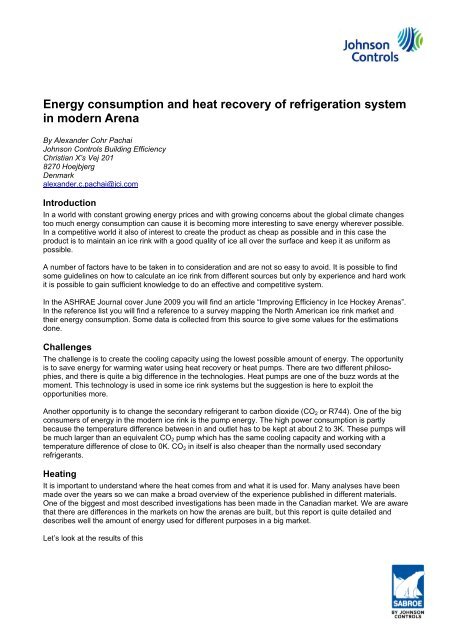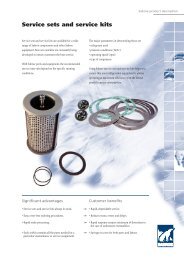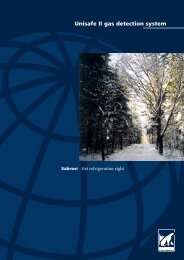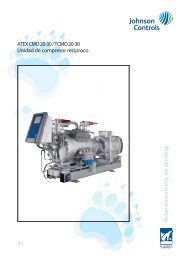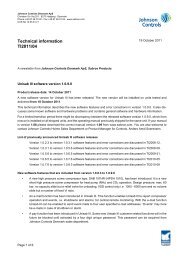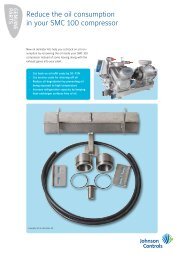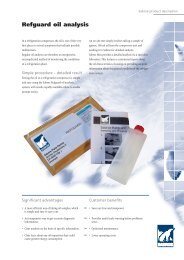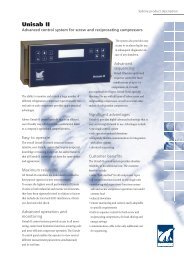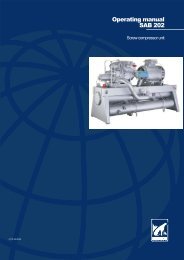Energy consumption and heat recovery of refrigeration ... - Sabroe
Energy consumption and heat recovery of refrigeration ... - Sabroe
Energy consumption and heat recovery of refrigeration ... - Sabroe
- No tags were found...
You also want an ePaper? Increase the reach of your titles
YUMPU automatically turns print PDFs into web optimized ePapers that Google loves.
In terms <strong>of</strong> money the energy in kWh/year for the most efficient arenas can be shown as follows:
RefrigerationHeating <strong>of</strong> st<strong>and</strong>sHeating <strong>and</strong> dehumidificationHot water for resurfacingDomestic hot waterLighting360,000 kWh/year232,000 kWh/year80,000 kWh/year48,000 kWh/year40,000 kWh/year40,000 kWh/year800000 kWh/year<strong>and</strong> if you want to use the Finnish market price <strong>of</strong> energy according to www.energy.eu you can calculate thisin to money:Finnish price <strong>of</strong> energy 0.0559 kWhhttp://www.energy.eu/Refrigeration20,124 €/yearHeating <strong>of</strong> st<strong>and</strong>s12,969 €/yearHeating <strong>and</strong> dehumidification 4,472 €/yearHot water for resurfacing 2,683 €/yearDomestic hot water2,236 €/yearLighting2,236 €/yearTotal expenditure 44,720 €/yearThe expenditure on hot water production can be reduced as shown in the calculation here under.Heat <strong>recovery</strong>Basically the <strong>heat</strong> <strong>recovery</strong> systems allow you to collect the <strong>heat</strong> from the <strong>refrigeration</strong> systems warm side.The primary function <strong>of</strong> the <strong>refrigeration</strong> system is to keep the ice cold <strong>and</strong> not to create how water. The coldside <strong>and</strong> the temperature required here are therefore determined by the ice rink <strong>and</strong> the purpose <strong>of</strong> it. Thewarm side is defined by what the <strong>refrigeration</strong> system can do for you. There is a limit to how high thecondensing pressure can become because you lose capacity as the condensing temperature increases <strong>and</strong>due to mechanical stresses in the system.In current ice rink systems part <strong>of</strong> the <strong>heat</strong> is recovered, but at a relative low level. If you are recovering thesuper<strong>heat</strong> <strong>of</strong> the compressed gas you can recover about 10% <strong>of</strong> the <strong>heat</strong> giving a temperature <strong>of</strong> about 60°Cgoing a capacity <strong>of</strong> about 30 kW going to 0 kW at 90°C.Alternatively you can use the condensing temperature between 20-40°C but with a capacity <strong>of</strong> 400 kW. Thehigher the condensing temperature becomes the lower the cooling capacity <strong>and</strong> the overall efficiencydecreases.A third possibility is to use a <strong>heat</strong> pump that can generate 70°C hot water using the warm side <strong>of</strong> the coolingsystem as <strong>heat</strong> source. Basically this is staging the compressor system <strong>and</strong> that has always been better forefficiency. This is the ultimate way to save money for space <strong>heat</strong>ing <strong>and</strong> for <strong>heat</strong>ing tap water also comparedto oil burners.We will demonstrate how it is possible to generate 70°C water at a competitive price using local prices forelectricity <strong>and</strong> natural gas.
The assumptionsWe will assume that the <strong>refrigeration</strong> plant has a condensing capacity around 400 kW at 30°C which is apretty st<strong>and</strong>ard <strong>refrigeration</strong> unit for a <strong>refrigeration</strong> unit in an arena. We also assume that the boiler has anefficiency <strong>of</strong> 100% although it is only close for new <strong>and</strong> high class boilers.The prices we use are taken from the EU price <strong>of</strong> gas <strong>and</strong> electricity which can be found on the Internet(http://www.energy.eu/). These prices are only average but good enough for our calculation. We have alsocompared the boiler with a comparable <strong>heat</strong> pump with the same <strong>heat</strong>ing capacity. This can be anadvantage for the boiler.We furthermore assume that the load is constant at full load although the price for the <strong>heat</strong> pump is includingvariable speed drive (VSD). The assumption also use 5040 hours or 7 months <strong>of</strong> operation at full loadconditions. This is an advantage for the boiler because they are not as efficient as the <strong>heat</strong> pump at partload.Heat pump price Installation price121,500.00 25,000.00Cost <strong>of</strong> installation Service/year (Apx)146,500.00 5,860.00We assume the cost <strong>of</strong> installation <strong>and</strong> the approximate cost <strong>of</strong> service on the unit. The price is based on aquotation from the sales department.What is not taken in to consideration is if you cannot use the <strong>heat</strong> in your own premises. In some cases youcan sell the surplus <strong>heat</strong> to neighbors provided the supply temperature is hot enough.The size <strong>of</strong> the unit chosen for the purpose is only designed to keep the condensing temperature <strong>of</strong> the icerink unit at st<strong>and</strong>ard conditions. This means that we have not considered the effect <strong>of</strong> lowering thecondensing pressure <strong>of</strong> the ice rink unit. Therefore it is possible to speed up the <strong>heat</strong> pump a little <strong>and</strong>reduce the condensing pressure. This will increase the performance by 3% each degree the condensingpressure on the ice rink unit is lowered.Your countryGas priceHeat capacityFinl<strong>and</strong>0.027 €/kWh10 kWh/m3Price <strong>of</strong> Electric power0.056 €/kWhWinterCapacity 100%Boiler capacity483.3 kWGas concumption48.33 m3/hRunning cost13.19 €/hHeat pump capacityElectricity <strong>consumption</strong>Running costYearly activitySaving483.3 kW83 kW4.64 €/h5760 Hours49,273.29 €/yearPrice <strong>of</strong> <strong>heat</strong> pump 146,500.00 €Simple pay back3.0 Years
Working with natural gas is not so straight forward as many might think. Some qualities fluctuate quite a lot<strong>and</strong> if the boiler is not looked after by a qualified engineer all the time it might stop from time to time or theefficiency will suffer substantially. Other suppliers have a very stable quality <strong>of</strong> gas which allows nosupervisionplants. Using <strong>heat</strong> pumps you are out <strong>of</strong> these thoughts as long as you have a stable powersupply.Basically you can see that the boiler has a coefficient <strong>of</strong> performance (COP) equal to 1 <strong>and</strong> the <strong>heat</strong> pumphas a COP = 483/83=5.82. Translated in to clear text it means for each amount <strong>of</strong> (gas/oil/coal) <strong>heat</strong>ingcapacity in kWh gives one kWh as output (without considering age <strong>and</strong> lower efficiency) compared to the<strong>heat</strong> pump that delivers 5.82 kWh for each kWh put in to the motor. This is without considering the increasedefficiency that comes with the lower condensing temperature <strong>of</strong> the <strong>refrigeration</strong> system.A simple estimate:Savings on the "cold" sideLower condensing temperature5 °C Coolinh load 350 kWNormal power input Condensing load 420 kW420 kW 23.478 €/h 135,233 €/yearNew power input357 kW 19.9563 €/h 114,948 €/yearTotal savings in runing cost per year 69,558.28 €Payback time 2.1 Years20,285 €/yearIf it is possible to lower the condensing temperature it will reduce the simple payback period for the system toabout 2.1 years. On top <strong>of</strong> this we can add the longer service life <strong>of</strong> the system because <strong>of</strong> less wear <strong>and</strong>tear from working with less load. Less service requirements can also come in to question due to betterrunning condition for the <strong>refrigeration</strong> system.Low cost reduction measuresThere are a number <strong>of</strong> possibilities <strong>of</strong> saving energy already widely used. Most <strong>of</strong> them are self evident butperhaps worthwhile mentioning:Increase the ice temperature during unoccupied periods or when the users do not need the very hard icesheet e.g. figure skating or free skating. One degree increased temperature on the ice sheet can result in 6%saving annually.Infrared sensors mounted over the ice sheet give a better temperature control than an embedded sensor.Reduce the ice thickness. Some ice rinks use very thick ice sheet but it has a penalty on the energy<strong>consumption</strong>Avoid running at high than necessary condensing pressure/temperature. One bar higher condensingpressure gives 3% additional energy <strong>consumption</strong>. It is in many cases better to use a dedicated <strong>heat</strong> pumpto produce hot water when needed.Reduce the space temperature <strong>and</strong> ventilation when not neededConsider other fluids e.g. CO 2 for new ice rinks. CO 2 pumps use about 10% <strong>of</strong> the energy for the samecooling capacity compared to glycol pumps.Consider lower flow rates in coolant to reduce the pump power absorptionReduce the lighting when possible <strong>and</strong> use motion sensors to switch <strong>of</strong>f light when rooms are not used.Heat pumps can be used to cool exhaust air <strong>and</strong> warm in coming air. Alternative is to use <strong>heat</strong> pipes usingCO 2 as <strong>heat</strong> transfer media.Space <strong>heat</strong>ing accounts for about 30% or more. A lot <strong>of</strong> possible solutions to conserve energy are availablehere. An important issue is to separate the air on st<strong>and</strong>s from the air over the ice sheet. The warm air is amajor contributor to <strong>heat</strong> load on the <strong>refrigeration</strong> systemVentilation rates can be controlled using CO 2 room sensorsConclusionsThe desire for saving energy in the ice arena <strong>and</strong> the main areas <strong>of</strong> focus falls in to two categoriesThe <strong>refrigeration</strong> system <strong>and</strong> tasks for operating <strong>and</strong> maintenance <strong>of</strong> the ice sheet
Heating, ventilation <strong>and</strong> dehumidification <strong>of</strong> st<strong>and</strong>s, rink, locker rooms <strong>and</strong> common areas.Hot water <strong>and</strong> lighting play a minor role in the big picture (each about 5%) but hot water is easy to produceefficiently <strong>and</strong> cheap by recovering <strong>heat</strong> from the <strong>refrigeration</strong> system. Lightning is a topic <strong>of</strong>ten discus.A low hanging fruit is to apply a <strong>heat</strong> pump that can provide high value hot water that can provide <strong>heat</strong>ing<strong>and</strong> hot water eliminating need <strong>of</strong> boilers.


